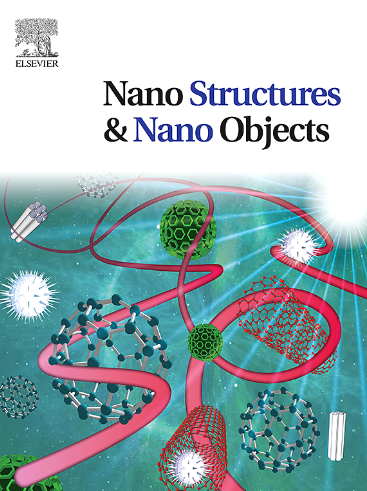微波辅助水热合成过程中ZnS:Cu纳米颗粒形貌的演变
IF 5.45
Q1 Physics and Astronomy
引用次数: 0
摘要
掺杂硫化锌(ZnS)纳米材料具有独特的光学和电学性能,是设计和制造光致发光(PL)和电致发光器件的优秀材料。纳米颗粒的结构、元素组成和形态决定了所生产器件的性能,并且对反应条件高度敏感。因此,应该探索实时监测,以便有机会为现场试验提取足够数量的材料。本文研究了微波辅助水热法制备的cu掺杂ZnS颗粒的形态演化过程。本研究证明了连续监测合成产物性质的可行性,为颗粒生长和形成过程提供了有价值的见解,同时也证实了所描述的采样程序的可重复性。结果证实,在合成过程中形成了立方ZnS相,晶粒尺寸从2 nm增加到5 nm。此外,通过x射线粉末衍射证实了六边形ZnO的形成。扫描透射电镜(STEM)图像揭示了具有不同形态标志的ZnS颗粒的形成和生长过程。一类粒子是由不同大小的纳米团簇形成的球形粒子,由于硫脲的缓慢分解。第二组花状颗粒是通过在球形颗粒表面开始生长薄片状的过程产生的。所得产物的PL强度位于2.00 eV处,表明Cu2+离子能级之间发生4T1→6A1跃迁,并随时间发生蓝移。本文章由计算机程序翻译,如有差异,请以英文原文为准。
Evolution of ZnS:Cu nanoparticle morphology during microwave-assisted hydrothermal synthesis
Doped zinc sulfide (ZnS) nanomaterials have unique optical and electrical properties making them an outstanding material for design and fabrication of photoluminescent (PL) and electroluminescent devices. Structure, elemental composition and morphology of nanoparticles determine properties of the produced devices and are highly sensitive to reaction conditions. Therefore, real-time monitoring with an opportunity to extract a sufficient quantity of material for the field tests should be explored. This work is devoted to the study of morphological evolution of Cu-doped ZnS particles synthesised by microwave-assisted hydrothermal method (MWHT). This study demonstrates the feasibility for continuous monitoring of synthesis product properties, offering valuable insights into particle growth and formation processes, while also confirming the reproducibility of the described sampling procedure. The results verify formation of a cubic ZnS phase with crystallite size increasing from 2 to 5 nm during the synthesis. In addition, formation of the hexagonal ZnO was confirmed by X-ray powder diffraction. Scanning transmission electron microscopy (STEM) images elucidated the formation and growth processes of ZnS particles with different morphological signs. One group of particles was represented as the spherical particles formed from nanoclusters in various sizes due to slow decomposition of thiourea. The second group of flower-like particles was generated through a process where thin-like plates commence to grow on the surface of spherical particles. PL intensity of the resulting products with a band positioned at 2.00 eV indicated 4T1 → 6A1 transition between Cu2+ ion energy levels and experienced a blueshift over time.
求助全文
通过发布文献求助,成功后即可免费获取论文全文。
去求助
来源期刊

Nano-Structures & Nano-Objects
Physics and Astronomy-Condensed Matter Physics
CiteScore
9.20
自引率
0.00%
发文量
60
审稿时长
22 days
期刊介绍:
Nano-Structures & Nano-Objects is a new journal devoted to all aspects of the synthesis and the properties of this new flourishing domain. The journal is devoted to novel architectures at the nano-level with an emphasis on new synthesis and characterization methods. The journal is focused on the objects rather than on their applications. However, the research for new applications of original nano-structures & nano-objects in various fields such as nano-electronics, energy conversion, catalysis, drug delivery and nano-medicine is also welcome. The scope of Nano-Structures & Nano-Objects involves: -Metal and alloy nanoparticles with complex nanostructures such as shape control, core-shell and dumbells -Oxide nanoparticles and nanostructures, with complex oxide/metal, oxide/surface and oxide /organic interfaces -Inorganic semi-conducting nanoparticles (quantum dots) with an emphasis on new phases, structures, shapes and complexity -Nanostructures involving molecular inorganic species such as nanoparticles of coordination compounds, molecular magnets, spin transition nanoparticles etc. or organic nano-objects, in particular for molecular electronics -Nanostructured materials such as nano-MOFs and nano-zeolites -Hetero-junctions between molecules and nano-objects, between different nano-objects & nanostructures or between nano-objects & nanostructures and surfaces -Methods of characterization specific of the nano size or adapted for the nano size such as X-ray and neutron scattering, light scattering, NMR, Raman, Plasmonics, near field microscopies, various TEM and SEM techniques, magnetic studies, etc .
 求助内容:
求助内容: 应助结果提醒方式:
应助结果提醒方式:


